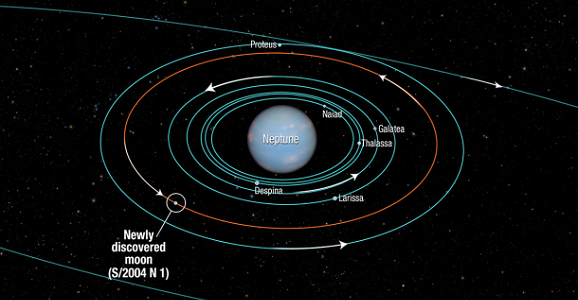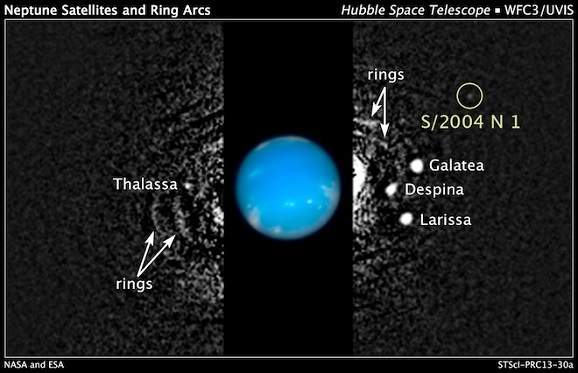Neptune’s Tiny 14th Moon Has Been Discovered
This article is more than 2 years old
 One of the most fascinating and humbling aspects of space exploration is that almost everything is billions of years older than the discovery. (Just once, I’d like to see someone find an advertisement for the iPhone 7 plastered all over an alien planet.) Every once in a while, though, astronomers don’t even realize what they’re looking at, and what should have been an old discovery takes a while to be found.
One of the most fascinating and humbling aspects of space exploration is that almost everything is billions of years older than the discovery. (Just once, I’d like to see someone find an advertisement for the iPhone 7 plastered all over an alien planet.) Every once in a while, though, astronomers don’t even realize what they’re looking at, and what should have been an old discovery takes a while to be found.
The SETI Institute’s Mark Showalter was studying images of Neptune’s rings taken back in 2009 by the Hubble Space Telescope. On July 1, he started looking along the outer edges of the rings when he noticed a white dot that neither he nor anybody else had identified before. And a new Neptunian moon was born, so to speak. It’s now called S/2004 N 1, just in case you were thinking of writing a song about it.
“The moons and arcs orbit very quickly, so we had to devise a way to follow their motion in order to bring out the details of the system,” said Showalter in a press release. “It’s the same reason a sports photographer tracks a running athlete — the athlete stays in focus, but the background blurs.”
Located around 65,400 miles from Neptune, between the orbits of Larissa and Proteus, the moon wasn’t even detected when NASA’s Voyager 2 craft surveyed Neptune via flyby in 1989. To confirm the moon’s legitimacy, Showalter and his colleagues compared over 150 photographs going back to 2004, plotting the moon’s orbit, which happens about once every 23 hours. In case you’re wondering how such a discovery took so long, S/2004 N 1 is only 12 miles across, and it’s 100 million times fainter than the faintest star our eyes are able to see. What’s really surprising is that anyone even noticed it now, and that something 12 miles across qualifies for moon status. By comparison, Neptune’s largest moon, Triton (and its possible subsurface oceans), is over 1,680 miles wide. (Our own moon is 2,160 miles across.)

Beyond being a cool discovery in general, it isn’t clear just how Neptune’s newly discovered moon managed to make it this long without crashing into and becoming a part of another moon, or just getting pummeled and destroyed by asteroids. “How you can have a 20-kilometre object around Neptune is a little bit of a puzzle,” says Showalter. “It’s far enough away that its orbit is stable. Once you put it there it will stay there. The question is, how did it get there?”
And now, of course, it’s going to need a more memorable name than that trail of letters and numbers. Neptune’s satellites get their name from minor Greek and Roman water deities, so this might not inspire a naming poll like Pluto’s moons received. For now, Showalter and his team just call it “little moon.” The names may be running short, as this is the fourteenth moon discovered around the planet.













